1. Arseven O, Ekim N, Müsellim B, et al. Pulmoner embolizm tanı vetedavi uzlaşı raporu. Türk Toraks Derneği: 2015.
2. Humbert M, Kovacs G, Hoeper M, et al. 2022 ESC/ERS Guidelines forthe diagnosis and treatment of pulmonary hypertension. Eur Heart J.2022;43(38):3618-3731.
3. Tiede H, Hooper MM, Richter M, Cacheris W, Hinzmann B, Mayer E.Global burden of chronic thromboembolic pulmonary hypertension(CTEPH): an epidemiological analysis. Eur Respir J. 2014;44(Suppl58):2326.
4. Benza RL, Miller DP, Gomberg-Maitland M, et al. Predicting survivalin pulmonary arterial hypertension insights from the registry toevaluate early and long-term pulmonary arterial hypertension diseasemanagement (REVEAL). Circ J. 2010;122(2):164-172.
5. Galie N, Hoeper MM, Humbert M, et al. Guidelines for thediagnosis and treatment of pulmonary hypertension. Eur Respir J.2009;34(6):1219-1263.
6. Moser KM, Fedullo PF, Finkbeiner WE, Golden J. Do patients withprimary pulmonary hypertension develop extensive central thrombi?Circ J. 1995;91(3):741-745.
7. Edward JA, Mandras S. An update on the management of chronicthromboembolic pulmonary hypertension. Curr Probl Cardiol.2017;42(1):7-38.
8. Galie N, Hoeper MM, Humbert M, et al. Guidelines for the diagnosisand treatment of pulmonary hypertension. The Task Force for theDiagnosis and Treatment of Pulmonary Hypertension of the EuropeanSociety of Cardiology (ESC) and the European Respiratory Society(ERS), endorsed by the International Society of Heart and LungTransplantation (ISHLT). Eur Heart J. 2009;30(20):2493-2537.
9. Dentali F, Donadini M, Gianni M, et al. Incidence of chronicthromboembolic pulmonary hypertension in patients with previouspulmonary embolism. Thromb Res. 2009:124(3):256-258.
10. Marti D, Gomez V, Escobar C, et al. Incidence of symptomatic andasymptomatic chronic thromboembolic pulmonary hypertension. ArchBronconeumol. 2010;46(12):628-633.
11. Poli D, Grifoni E, Antonucci E, et al. Incidence of recurrent venousthromboembolism and chronic thromboembolic pulmonaryhypertension in patients after a first episode of pulmonary embolism. JThromb Thrombolysis. 2010;30(3):294-299.
12. Korkmaz A, Ozlu T, Ozsu S, Kazaz Z, Bulbul Y. Long term outcomesin acute pulmonary thromboembolism: the incidence of chronicthromboembolic pulmonary hypertension. Clin Appl Thromb Hemost.2012;18(3):281-288.
13. Klok F, van Kralingen KW, van Dijk APJ, Heyning FH, Vliegen HW,Huisman MV. Prospective cardiopulmonary screening program todetect chronic thromboembolic pulmonary hypertension in patientsafteracute pulmonary embolism. Haematol. 2010;95(6):970-975.
14. Becattini C, Agnelli G, Peasvento R, et al. Incidence of chronicthromboembolic pulmonary hypertension after a first episode ofpulmonary embolism. Chest. 2006;130(1):172-175.
15. Pengo V, Lensing A, Prins M, et al. Incidence of chronicthromboembolic pulmonary hypertension after pulmonary embolism.N Eng J Med. 2004;350(22):2257-2264.
16. Surie S, Gibson NS, Gerdes VE, et al. Active search for chronicthromboembolic pulmonary hypertension does not appear indicatedafter acute pulmonary embolism. Thromb Res. 2010;125(5):e202-e205.
17. Kayaalp İ, Varol Y, Çimen P, et al. The incidence of chronicthromboembolic pulmonary hypertension secondary to acutepulmonary embolism. Tuber Toraks. 2014;62(3):199-206.
18. Morris TA. Why acute pulmonary embolism become chronicthromboembolic pulmonary hypertension: clinical and geneticalinsights. Curr Opin Pulm Med. 2013;19(5):422-429.
19. Cilingir B, Günbatar H. Chronic thromboembolic pulmonaryhypertension. Van Tıp Derg. 2016;23(1):125-131.
20. Paraskos JA, Adelstein SJ, Smith RE, et al. Late prognosis of acutepulmonary embolism. N Engl J. 1973;289(2):55-58.
21. Yang Suqiao, Yang Y, Zhai Z, et al. Incidence and risk factors of chronicthromboembolic pulmonary hypertension in patients after acutepulmonary embolism. J Thorac Dis. 2015;7(11):1927-1938.
22. Liu P, Meneveau N, Schiele F, Bassan JP. Predictors of long-term clinicaloutcome of patients with acute massive pulmonary embolism afterthrombolytic therapy. Chin Med J. 2003;116(4):503-509.
23. Ribeiro A, Lindmarker P, Johnsson H, Juhlin-Dannfelt A, JorfeldtL. Pulmonary embolism: one year follow up with echocardiographydoppler and five year survival analysis. Circulation. 1999;99(10):1325-1330.
24. Kaeron C. Natural history of venous thromboembolism. Circ J.2003;(1):122-130.
25. Martinez C, Wallenhorts C, Teal S, Cohen AT, Peacock AJ. Incidenceand risk factors of chronic thromboembolic pulmonary hypertensionfollowing venous thromboembolim, a population based cohort study inEngland . Pulm Circ. 2018;8(3):2045894018791358.
26. Klok FA, Dzikowska O, Kostrubiee M, et al. Derivation of a clinicalprediction score for chronic thromboembolic pulmonary hypertensionafter acute pulmonary embolism. Thromb Haemos. 2016;14(1):121-128.

